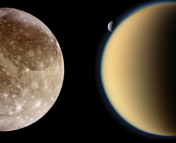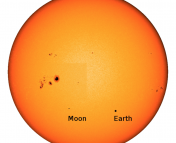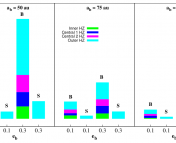Title: Active Cryovolcanism on Europa?
Authors: William B. Sparks, Britney E. Schmidt, Melissa A. McGrath, Kevin P. Hand, John .R. Spencer, Misty Cracraft, and Susana E. Deustua
First Author’s Institution: Space Telescope Science Institute
Status: Submitted, open access
Europa, one of Jupiter’s Galilean moons, is one of the most exciting places in the search for alien life in our solar system, rivaling both Mars and Saturn’s moon Enceladus. Underneath a 15-25 km surface layer of ice, Europa very likely has a thick (~100 km) ocean of salty water with a rocky seafloor. Chemical reactions on the icy surface caused by high-energy particles from Jupiter’s radiation belts could provide some of the essential ingredients for life, but only if this material could somehow reach the liquid water beneath it. These geological properties make Europa a prime candidate for potential alien life.
Cryovolcanism and Cryogeysers
Cryovolcanoes are similar to the volcanoes here on Earth with subsurface “magma” being expelled from the planet’s interior and then solidifying on the surface. For cryovolcanoes though, this “magma” is liquid water instead of molten rock. Both types of volcanism require internal heat sources. On Earth, this primarily comes from the residual heat of Earth’s formation and radioactive decay. For the icy moons of the outer solar system, the main expected heat source is from tidal heating. There are many suspected or possible examples of cryovolcanism in the solar system on many different bodies: Ceres, Europa, Enceladus, Titan, Miranda, Triton, Pluto, Charon, and Quaoar, although none have been definitively confirmed.
Cryogeysers are similar in some aspects to cryovolcanoes (and are sometimes included in the definition of “cryovolcanism”). However, cryogeysers expel volatile gases (with some solid particles) instead of a liquid magma/lava. Examples of this are known on Enceladus, Triton, and Mars’ ice caps. Hubble observations from 2013 and 2014 also suggested the existence of cryogeysers on Europa by finding what appears to be plumes of water vapor rising above Europa’s surface, although this was not seen in every observation. This created uncertainty as to whether the signal was truly there or whether the plumes are just variable.
New Evidence of Cryovolcanism on Europa
The authors of the article in today’s Astrobite did follow-up Hubble observations in early 2016. They also observed a potential plume of water vapor in the same location as the previous observations, although they were still unable to definitively confirm it. There are two popularly supported mechanisms for creating these plumes: an explosion of dissolved gases in a pressurized liquid after the outside pressure has been removed and the expansion of ice when a trapped body of water freezes that then breaks out of its enclosure.
The location of the new plume candidate also matches the location of a thermal hotspot on Europa’s surface that was first detected by the Galileo spacecraft in 1999, the cause of which remains unknown. The hotspot could be due to the ice layer being very thin at this point (~2 km) or potentially a large reservoir of liquid water trapped in the middle of the ice layer. Another source could be from internal heating, such as tidal heating that is somehow focused into that location or plumes of warm water underneath the icy surface. Alternatively, the thermal hotspot could just hold onto its heat better than the rest of the surface (i.e., it has a higher thermal inertia). This could be caused by different materials being deposited on the surface of the hotspot due to local vents/cryogeysers. The potential plume and hotspot, however, do not correspond to any surface features that might help explain their source.

Figure 1: A zoom-in of Europa’s surface. Panel (a): the green ellipse signifies the location of a 2014 candidate plume, while the cyan ellipse signifies the location of the 2016 candidate plume from this new paper. Panel (b): a contour heat map of the same region of Europa showing the hotspot located at the same position as the two candidate plumes from Panel (a).
Conclusions
While the authors were unable to definitively prove the existence of a water vapor plume, they did produce strong evidence of its existence, tying it together with a previous plume candidate and a thermal hotspot that appears in the same location. This is hard to explain away as a mere coincidence. The authors believe that this likely means that the icy surface layer is particularly thin in that region (~2 km thick instead of the usual 15-25 km) or that material has been deposited on that region from a local cryogeyser/vent. These observations add to the growing body of evidence that Europa may have the conditions necessary to host life.





Trackbacks/Pingbacks